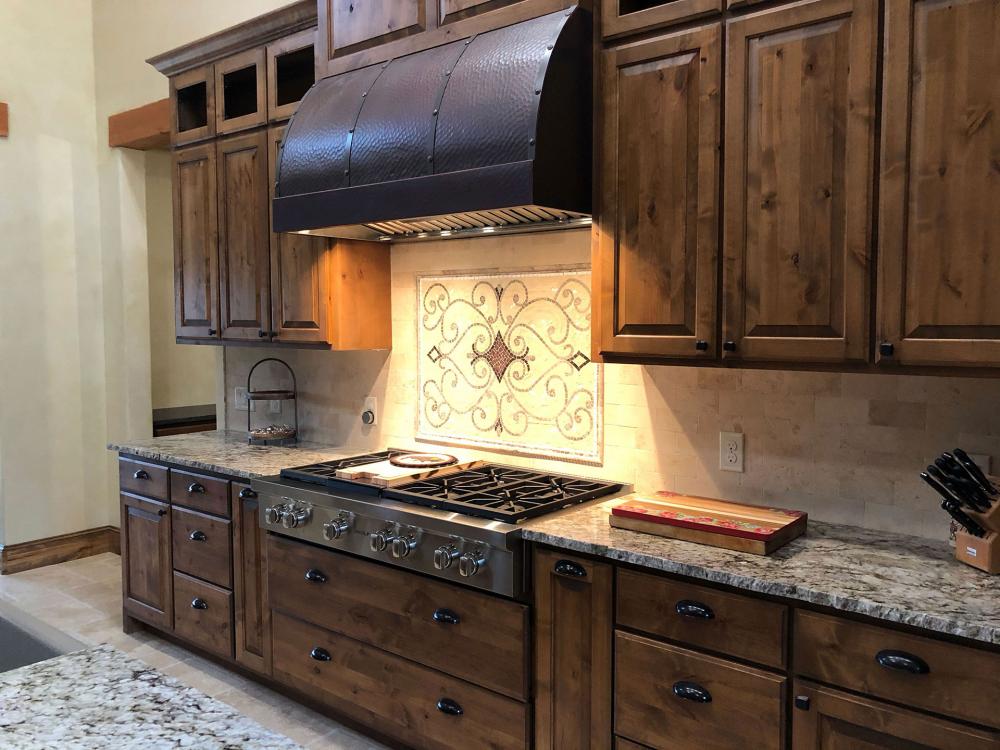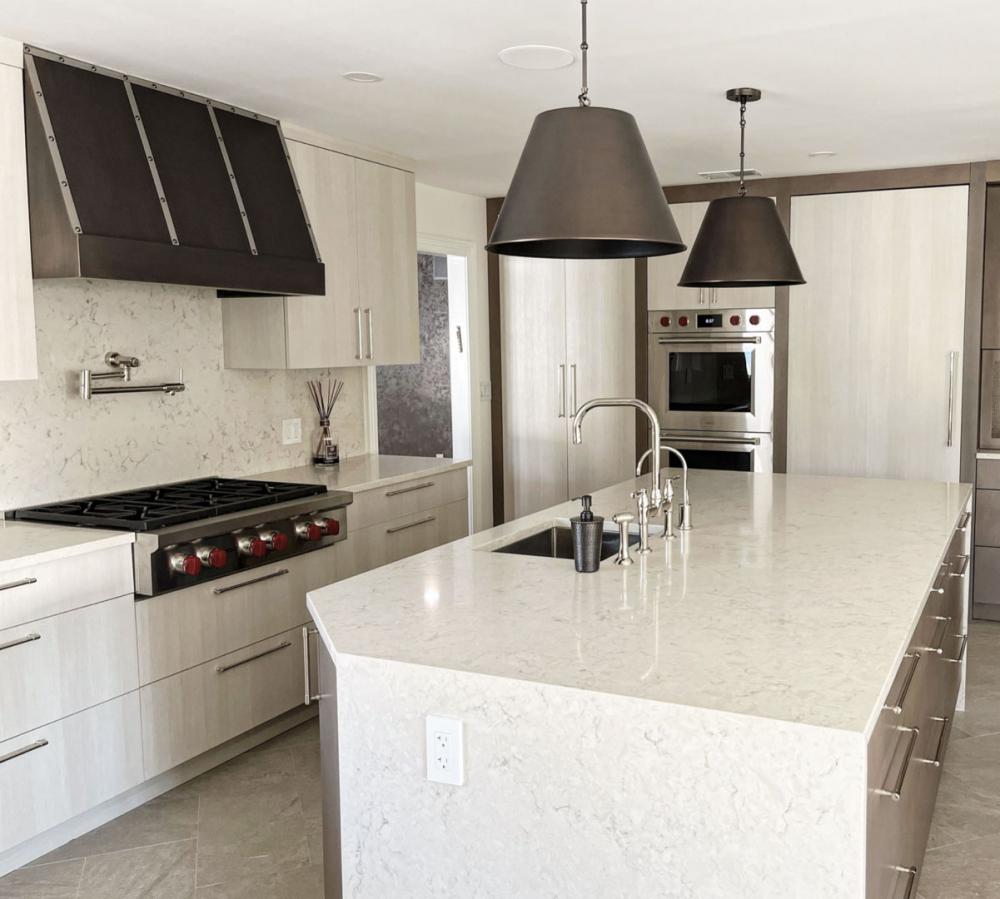
When renovating or upgrading your kitchen, one important aspect that should not be overlooked is the kitchen vent hood. A kitchen vent hood, also known as a custom range hood, plays a vital role in maintaining good indoor air quality by effectively removing smoke, steam, and odors that are produced during cooking.
 Not only are they useful for keeping your kitchen free of smoke, but they’re also a safety feature you really don’t want to go without. But with so many options available on the market, like under cabinet hoods and downdraft hoods, choosing the right kitchen vent hood can be overwhelming.
Not only are they useful for keeping your kitchen free of smoke, but they’re also a safety feature you really don’t want to go without. But with so many options available on the market, like under cabinet hoods and downdraft hoods, choosing the right kitchen vent hood can be overwhelming.
In this article, we’ll walk you through everything you need to purchase a kitchen vent hood.
From a basic definition of what the different hood types do to a recommendation of which hood is best suited to your needs.
What Is a Kitchen Vent Hood?
A kitchen vent hood, also known as a range hood, is an appliance installed above the cooktop or stove in the kitchen. It consists of a canopy or hood that covers the cooktop and a fan or blower that draws in air from the kitchen and vents it to the outside. These often-overlooked kitchen features are far more important than many people give them credit for. The primary function of a kitchen vent hood is to remove smoke, steam, and cooking odors from the air that are produced during cooking, but it also helps to remove excess heat and moisture.
More often than not, you’ll see them used when something in the kitchen is burning or producing too much steam or smoke. The vent hood does as its name suggests and “vents” the material out of your kitchen. Luckily, since kitchens are all designed differently, vent hoods also come in various sizes and styles to fit these different configurations and designs.
They can be mounted on the wall or under a cabinet and ducted or ductless. Ducted kitchen vent hoods exhaust air to the outside through a duct that runs through the roof or exterior wall of the house. In contrast, ductless hoods use a filtration system to remove odors and smoke before recirculating the air back into the kitchen.
Kitchen vent hoods not only improve the air quality in your kitchen but also prevent the accumulation of grease and smoke on your cabinets, walls, and ceiling. They can also add a decorative element to your kitchen and enhance the overall value of your home. There are several other features to consider that are discussed in detail below.
Types of Kitchen Vent Hoods
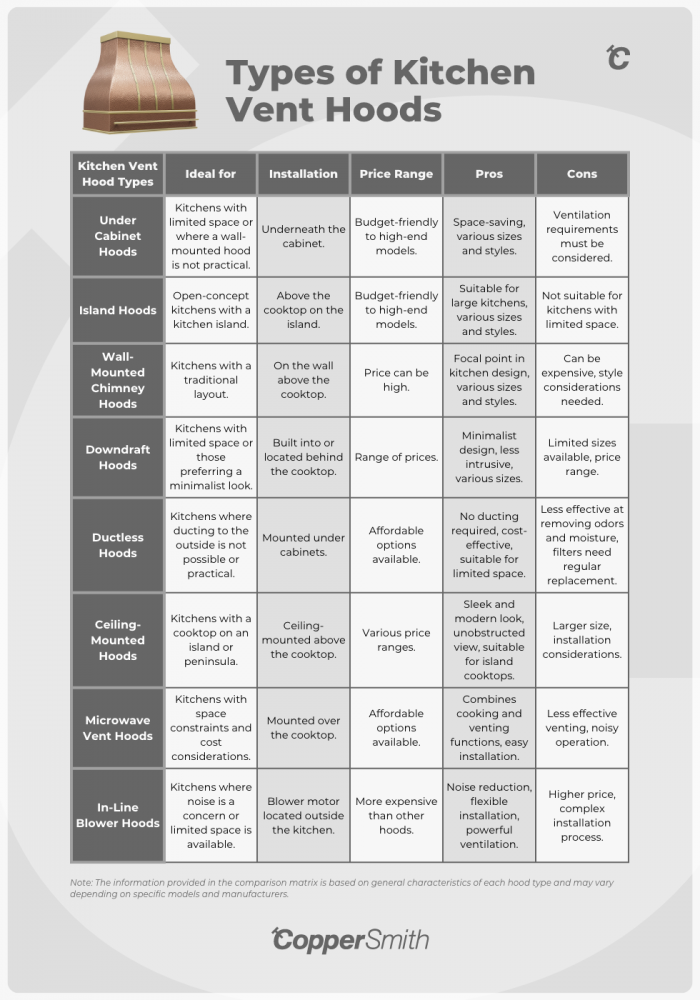
When selecting a kitchen vent hood, you will have to pick through numerous types available on the market. Some of the most popular types include under-cabinet hoods, island hoods, wall-mounted chimney hoods, downdraft hoods, and ductless hoods.
Each type of hood has its own unique features and benefits, and choosing the right one will depend on your kitchen layout, cooking needs, and personal preferences. In the next section, we will describe each type of kitchen vent hood in more detail to help you make an informed decision.
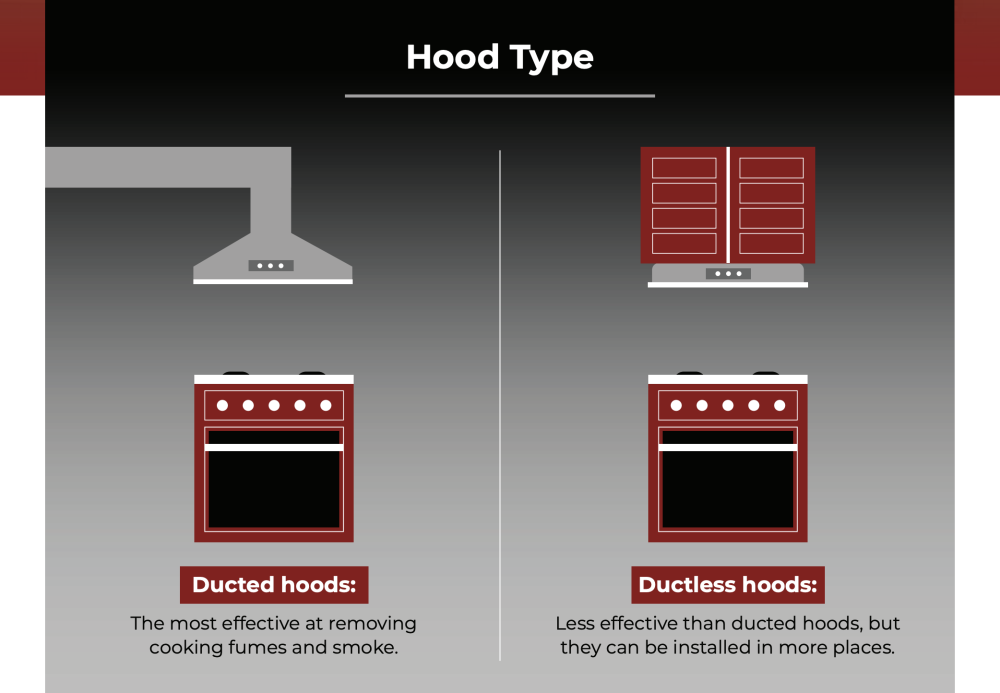
Under Cabinet Hoods
Under cabinet hoods are a popular kitchen vent hood mounted underneath the cabinet above the cooktop. This type of hood is ideal for kitchens with limited space or where a wall-mounted hood is not practical. They are much thinner than many vent hood types.
Under cabinet hoods are typically designed to fit a standard cabinet width and come in various sizes and styles. They are suitable for gas and electric cooktops and range in price from budget-friendly to high-end models with advanced features.
If you’re interested in an under cabinet vent hood, it is important to keep the size of your cooktop in mind, as well as the ventilation requirements for your kitchen. These are necessary requirements that far outweigh the style or design your kitchen might conform to.
You’re going to want to look for a hood with a fan that can handle the size of your cooktop and has sufficient airflow to remove smoke, steam, and cooking odors. Additionally, we recommend keeping the fan's noise level, the type of filter used, and the ease of cleaning and maintenance in mind.
Island Hoods
Island hoods are another type of kitchen vent hood designed to be mounted above a cooktop located on a kitchen island. This hood type is ideal for open-concept kitchens where the cooktop is located away from the walls. More often than not, you’ll see these vent hoods in large, open kitchens. They are not the best choice for kitchens that are limited in space.
Island hoods are typically larger than others and come in various sizes and styles. They are suitable for gas and electric cooktops and range in price from budget-friendly to high-end models with advanced features.
If this type of vent hood is something you’re interested in, first, make sure that it suits the size of your cooktop and any special requirements your kitchen has.
Make sure you also start shopping with a few other pieces of information, including the exact size of your island, the height of your ceiling, and the style you’re interested in. You can get these hoods in a few different colors and materials.
Wall-Mounted Chimney Hoods
Wall-mounted chimney hoods are a type of kitchen vent hood that is mounted on the wall above the cooktop. These are far more common than island hoods.
This hood type is ideal for kitchens with a traditional layout and is often used as a focal point in the kitchen design. These large vent hoods are often given more consideration than a smaller type, like the under cabinet hood.
Wall-mounted chimney hoods, like all varieties of range hoods, come in various sizes and styles. They can be paired up with gas and electric cooktops, as well. When shopping, you will want to keep an eye on the price as some of these can be quite expensive.
When shopping for a wall-mounted chimney hood, style is also important. Some are darker in color, while others are lighter. They also come in quite different shapes and sizes. A 30” vent hood is the most common but they can range from 21” to 60”.
Downdraft Hoods
Downdraft hoods are a type of kitchen vent hood that is installed directly into the cooktop or is located behind the cooktop. This is the least-intrusive version of a vent hood on the market. They’re completely out of sight and come in a range of prices.
Downdraft hoods are great for kitchens with limited space or for those who prefer a minimalist look. This type of ventilation usually starts at around $1,000 and goes up from there. The most common sizes are 30” and 36”.
Ductless Hoods
Ductless hoods, also known as recirculating hoods, are a type of kitchen vent hood that does not require an external vent to the outside. Instead, they use filters to clean and recirculate the air into the kitchen. These are quite common and are often mounted under cabinets above the stove.
This hood type is ideal for kitchens where ducting to the outside is not possible or practical. These hoods can also be one of the most affordable options for your kitchen and are often used when there is not a huge amount of space to work with.
When making your decision, you will want to look for a hood with a fan that can handle the size of your cooktop and has sufficient airflow to remove smoke, steam, and cooking odors.
Other important considerations include the type of filter used, as well as the ease of cleaning and maintenance. It is also important to note that ductless hoods are not as effective at removing cooking odors and moisture as vented hoods, and the filters need to be replaced regularly to maintain optimal performance.
Ceiling-Mounted Hoods
Ceiling-mounted hoods are designed to be mounted on the ceiling above a cooktop, providing a sleek and modern look to the kitchen. These hoods come in various styles, such as flush-mounted or suspended, and can be ducted or ductless.
Ceiling-mounted hoods are ideal for kitchens with a cooktop located on an island or peninsula where there is no available wall to mount a traditional wall-mounted hood.
Ceiling-mounted hoods provide an unobstructed view of the kitchen and are typically larger than island hoods to accommodate the distance from the cooktop to the ceiling.
Microwave Vent Hoods
Microwave vent hoods combine a microwave oven and a vent hood. These hoods are designed to be mounted over a cooktop and provide cooking and venting functions in one appliance. Microwave vent hoods are typically more affordable than other vent hoods and are easy to install.
However, they are not as effective at venting as dedicated vent hoods, and the fan can be noisy during operation. If you choose a microwave vent hood, select a model with a high CFM rating and multiple fan speeds to maximize airflow and reduce noise.
In-Line Blower Hoods
In-line blower hoods, also known as remote blower hoods, are a type of vent hood where the blower motor is located outside the kitchen, typically in the attic or on the roof.
These hoods are ideal for kitchens where noise is a concern, as the motor is located away from the cooking area. In-line blower hoods are also suitable for kitchens with limited space, as they allow for more flexibility in hood design and installation.
However, in-line blower hoods can be more expensive than other vent hoods, and the installation process can be more complex. In-line blower hoods can also provide more powerful ventilation than other vent hoods, as the hood's size or location does not restrict the motor.
Vent Hood Features to Consider
When browsing range hoods, there are several important features and options to consider that will make all the difference in your kitchen. These include things like fan speed control, lighting, noise level, and energy efficiency.
Make sure you have a fulsome understanding of these features and their respective benefits before you go shopping, as they’re sure to help you choose a vent hood that fits your needs and preferences. Here are a few of the key vent hood features to consider when shopping:
Materials
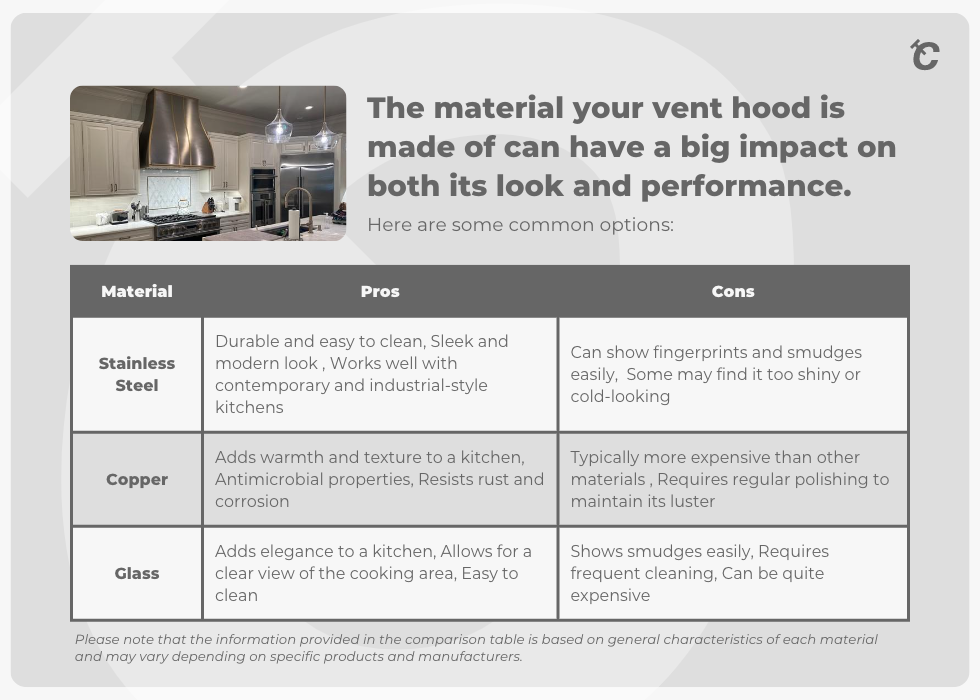
The material your vent hood is made of can have a big impact on both its look and performance. Here are some common options:
- Stainless Steel: Stainless steel is a popular material for vent hoods, as it is durable, easy to clean, and has a sleek, modern look. It works well with contemporary and industrial-style kitchens. However, stainless steel can show fingerprints and smudges easily, and some homeowners may find it too shiny or cold-looking.
- Copper: Copper is a trendy choice for vent hoods, as it adds warmth and texture to a kitchen. It is also antimicrobial and resists rust and corrosion. However, copper is typically more expensive than other materials, and it requires regular polishing to maintain its luster.
- Glass: Glass vent hoods can add a touch of elegance to a kitchen, as they allow for a clear view of the cooking area. They are easy to clean and can work well with modern and minimalist kitchens. However, they may show smudges and require frequent cleaning. Plus, they can be quite expensive.
Airflow
The airflow of a vent hood is measured in cubic feet per minute (CFM), and it determines how effectively the hood can remove smoke, steam, and odors from the kitchen. Here are some things to consider:
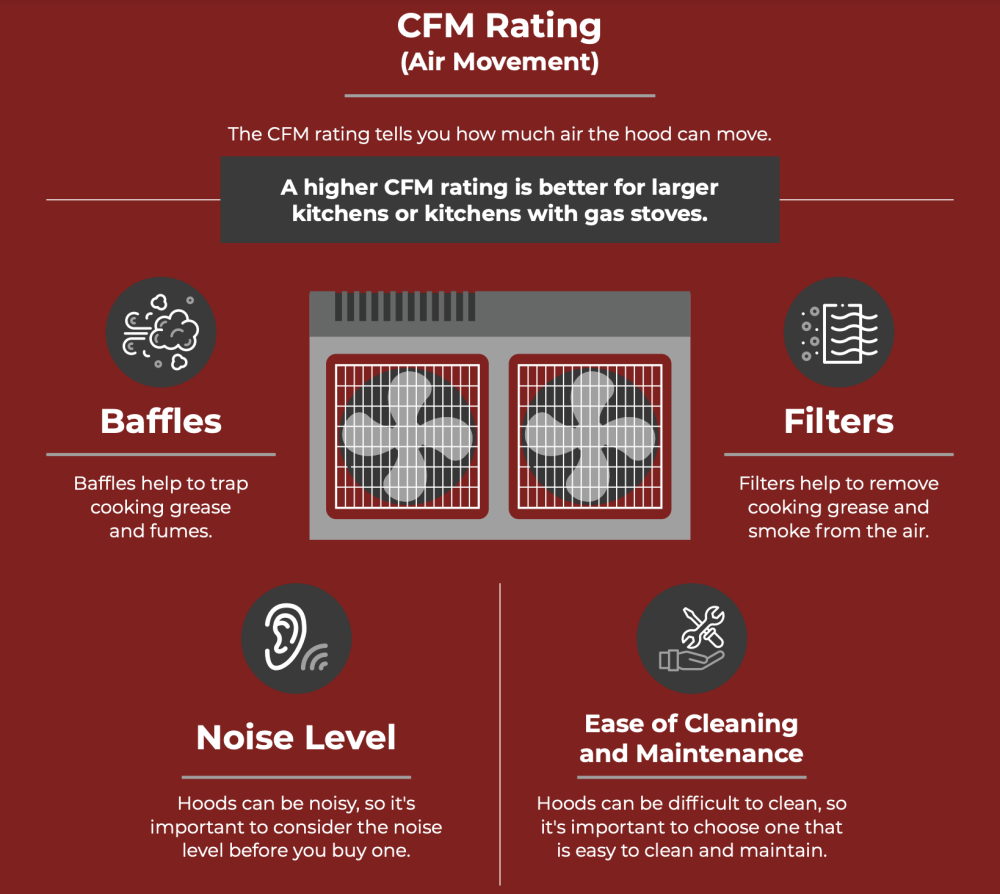
- CFM Rating: The CFM rating of your vent hood should be appropriate for the size of your cooktop, and the amount of cooking you do. A general rule of thumb is to choose a hood with at least 1 CFM per 100 BTUs of cooking power.
- Ducted vs. Ductless: Ducted vent hoods are more effective at removing smoke and odors from the kitchen, as they vent the air outside of the home. However, ductless hoods can be more convenient and easier to install, as they recirculate the air back into the kitchen after filtering it.
Filters
Filters are an important part of all range hoods, as they capture grease, smoke, and other particles before they can escape into the kitchen. Here are some things to consider:
- Type of Filter: There are several filters to choose from, including baffle filters, mesh filters, and charcoal filters. Baffle filters are the most effective at capturing grease, while charcoal filters are best for removing odors.
- Maintenance: Filters should be cleaned or replaced regularly to maintain the performance of your vent hood. Some filters are dishwasher-safe, while others must be hand-washed.
Fan Speeds
Most vent hoods offer multiple fan speeds, allowing you to adjust the airflow depending on your cooking needs. Here are some things to consider:
- Noise Level: Higher fan speeds can lead to more noise, which may concern some homeowners. Look for a hood with a low sone rating to ensure quieter operation.
- Power Efficiency: Higher fan speeds also use significantly more energy, so consider how often you need to use the hood at maximum power and whether energy efficiency is a priority in your home.
Thermostat Control
Some vent hoods come with thermostat control, allowing you to set the fan speed based on the temperature in the kitchen. Here are some things to consider:
- Convenience: Thermostat control can be convenient, allowing the hood to adjust automatically to changing cooking temperatures.
- Cost: Vent hoods with thermostat control tend to be more expensive than those without. So make sure that it’s something that you really need before adding this feature.
Size
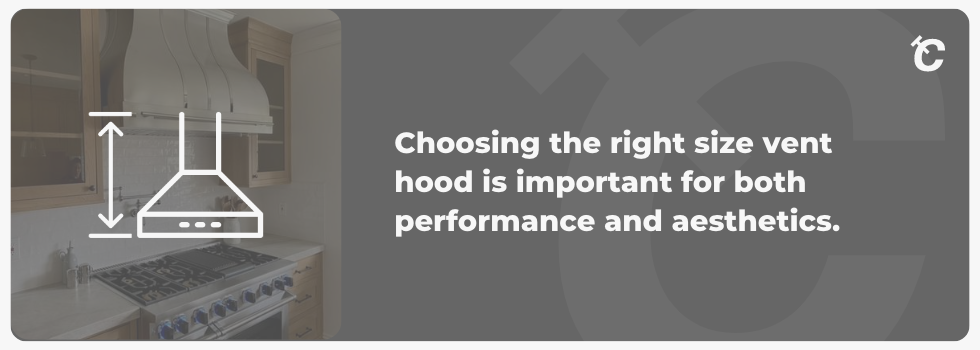
Choosing the right size vent hood is important for both performance and aesthetics. If you have a high ceiling, you'll need a vent hood designed to accommodate that height. Many vent hoods are designed to be adjustable, at least to an extent, so you can ensure that the hood is positioned at the optimal height for maximum effectiveness.
Another factor to consider is the space between your cabinets and other appliances. If your stove is located against a wall, you'll need a vent hood that's designed to be mounted on the wall. If your stove is located on an island or in a location where a wall-mounted hood isn't possible, you'll need an island or downdraft hood instead.
Additional Features to Consider
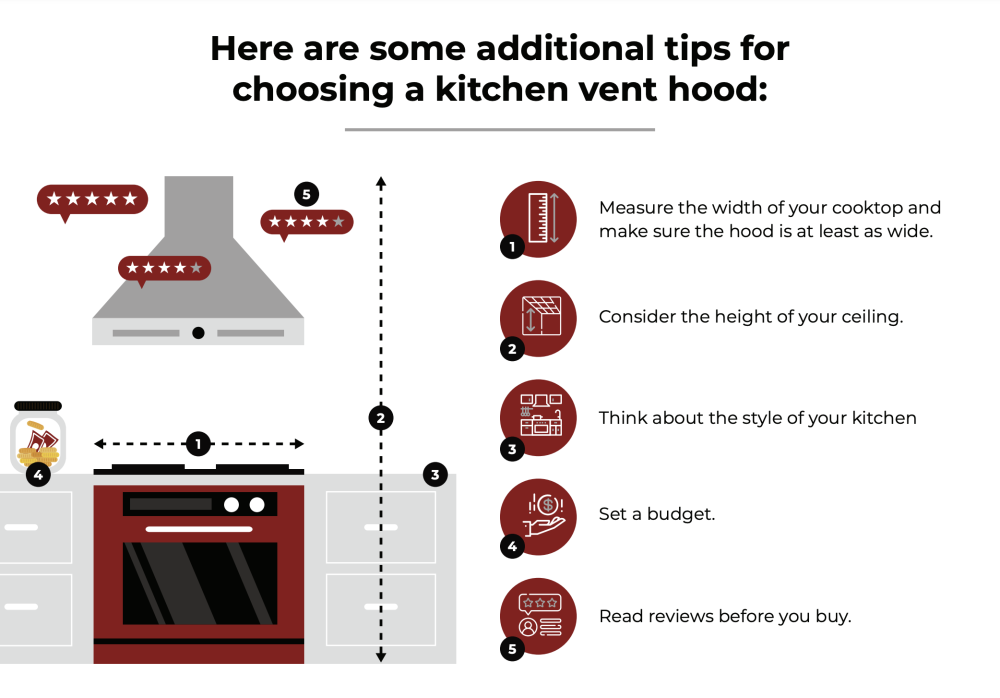
Here are a few other features you may want to keep in mind while you’re shoping for range hoods:
Exhaust Timers
Exhaust timers are an important feature that allows you to set a specific time for the vent hood to run after you finish cooking. This is a great feature for busy households or those who tend to forget to turn off their hood after cooking.
Setting a timer ensures that any residual smoke or odors are effectively removed from the kitchen, even if you're not there to turn it off yourself.
Noise Level
Vent hoods can produce a significant amount of noise, which can be disruptive in an open-concept kitchen or a space that's adjacent to living areas. If you want to avoid this inconvenience, look for vent hoods with noise-reduction features such as insulated motors or sound baffles.
Keep in mind that larger fans will typically produce more noise, so consider the size of the fan for your kitchen's needs.
Indoor vs. Outdoor
While most vent hoods are designed for indoor use, outdoor vent hood options are also available.
Outdoor vent hoods are typically made from durable materials such as stainless steel and are designed to withstand the elements. If you plan on cooking outdoors frequently or have an outdoor kitchen, make sure you’re shopping for this specific type.
Style and Aesthetics
Finally, consider the style and aesthetics of the vent hood you choose. Vent hoods come in various styles and finishes, so you can choose one that complements your kitchen's décor.
For a seamless look, consider a vent hood that can be integrated into your cabinetry or a hidden downdraft vent. Consider a statement piece such as a decorative chimney hood for a more dramatic look.
Frequently Asked Questions
Here are answers to some common questions about kitchen vent hoods:
Do kitchen hoods have to vent outside?
Not necessarily. While many vent hoods are designed to vent outside, ductless models are available that use filters to remove smoke and odors before recirculating the air back into the kitchen. However, venting outside is generally considered the most effective way to remove smoke, steam, and odors from your kitchen.
What is the difference between a range hood and a vent hood?
There is no real difference between a range hood and a vent hood. They are two names for the same appliance, which is designed to remove smoke, steam, and odors from your kitchen while you cook.
Do kitchen hood vents really work?
Yes, kitchen hood vents really do work. When properly installed and maintained, they can effectively remove smoke, steam, and odors from your kitchen. However, it's important to choose the right size and type of vent hood for your cooking needs and to keep the filters clean and well-maintained for optimal performance.
Which type of kitchen hood is best?
The best type of kitchen hood for your home depends on your cooking needs, kitchen layout, and personal preferences. Under-cabinet hoods are a popular and affordable option for those with limited space, while copper island hoods are a good choice for those with a kitchen island.
Wall-mounted chimney hoods are ideal for those with a traditional range setup, and downdraft hoods are a good option for those who prefer a minimalist look.
Final Thoughts
Choosing the right kitchen vent hood is an important decision that requires careful consideration of your cooking needs, kitchen layout, and personal preferences.
By understanding the different types of hoods available and the various features to consider, you can make an informed decision and select a hood that effectively removes smoke and odors from your kitchen while complementing your home's individual style type

